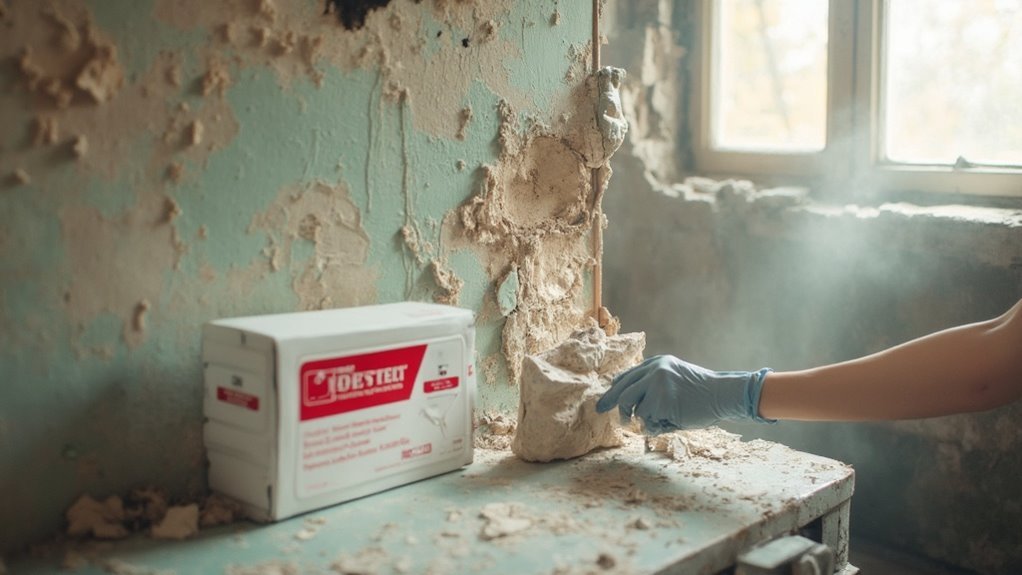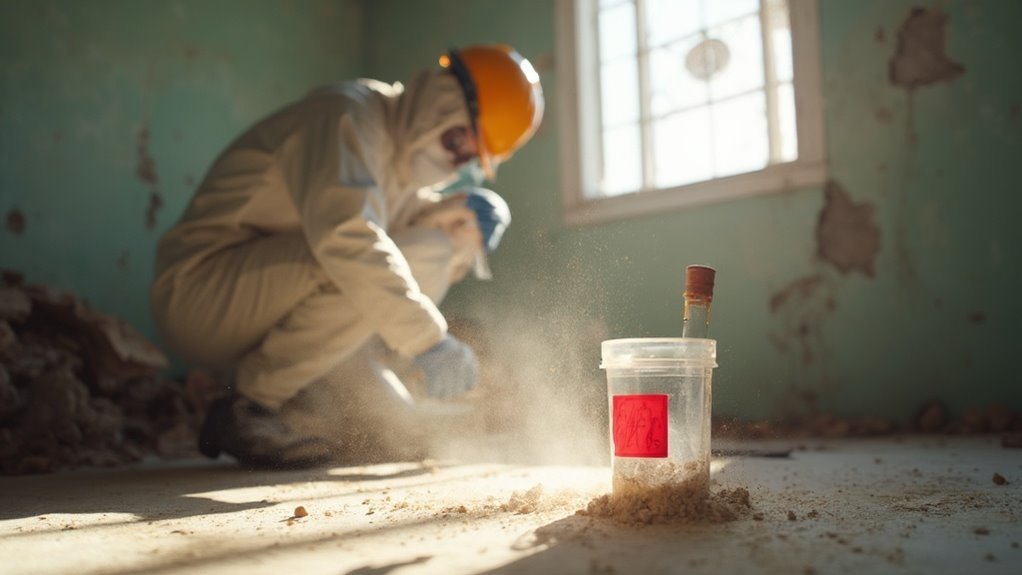Before starting any construction or renovation project, you're risking serious health hazards and regulatory concerns by not testing for asbestos. This material can lurk in insulation, flooring, and roofing, posing long-term health risks like asbestosis and mesothelioma. Complying with laws such as NESHAP and AHERA is essential to avoid costly penalties and guarantee safety for workers and residents alike. Effective testing identifies asbestos-containing materials, allowing for informed handling and planning. Implementing proper testing techniques not only protects health but also streamlines project execution. There's more to uncover about testing methods and their significant benefits for your project.
Reasons for Asbestos Testing

Before starting any renovation or demolition project, it's vital to understand the reasons for asbestos testing. Asbestos can appear in various materials, including insulation, flooring, and roofing. Knowing the asbestos types present is imperative for implementing effective management and removal strategies. Regular testing guarantees compliance with health and safety regulations, protecting workers, residents, and the general public from hazardous exposure. Additionally, there is no safe level of asbestos exposure, making testing even more critical.
Testing frequency plays a significant role in maintaining a safe environment. By identifying asbestos-containing materials early, you can prevent costly project delays and unexpected expenses. This proactive approach helps you plan for proper asbestos removal, guaranteeing compliance with disposal regulations for hazardous materials. Furthermore, a thorough asbestos testing survey is essential for project success and can streamline the management process.
Furthermore, testing helps safeguard employees from long-term health issues associated with asbestos exposure, such as asbestosis and lung cancer. It's not just about compliance; it's about protecting lives and maintaining a safe work environment.
Ultimately, integrating thorough asbestos testing into your project timeline not only reduces health risks but likewise supports environmental monitoring, preventing contamination and pollution. By prioritizing asbestos testing, you can secure a safer, more efficient project from start to finish.
Legal and Regulatory Requirements
When planning a project involving potential asbestos exposure, you must comply with specific legal and regulatory requirements. Engaging a certified consultant for asbestos surveys is crucial, as they guarantee thorough inspections and accurate documentation. Furthermore, be aware of the notification periods required for both local and emergency situations to avoid penalties and maintain safety. Additionally, understanding state regulations can help protect against health risks and financial liabilities associated with asbestos.
Compliance With Regulations
Asbestos testing is a critical component of regulatory compliance for any renovation or demolition project. You must understand that both federal and local regulations, such as NESHAP and AHERA, mandate rigorous testing protocols. All commercial buildings require this testing, regardless of age, while residential structures built before January 1, 2004, must likewise undergo an asbestos survey before any work commences.
In certain jurisdictions, like New York City, specific rules apply; for instance, buildings constructed before April 1, 1987, need an asbestos assessment. Public schools must follow the stringent guidelines outlined in AHERA, which includes initial inspections and ongoing management plans.
Failing to comply with these regulations can lead to severe consequences, such as legal penalties, financial liabilities, and increased health risks from asbestos exposure. Therefore, ensuring compliance with these testing protocols not only protects you legally but equally safeguards the health of everyone involved in the project.
Certified Consultant Requirement
Ensuring compliance with regulations involves not just awareness of testing protocols but in addition engaging certified consultants who specialize in asbestos management. To meet the legal requirements, you must verify the consultant qualifications, which include specific educational and experiential criteria. A certified consultant typically needs three years of asbestos-related experience alongside an associate's degree, or four years of experience with a high school diploma. Moreover, they must possess valid AHERA training certificates relevant to their claimed experience.
The certification process is rigorous. It begins with submitting a completed application to the Division, which includes a signed "Statement of Citizenship, Alienage, and Immigration Status for State Public Benefits" form. You must as well provide written references and pass a written examination with a minimum score of 70%. This examination covers crucial regulations and practices outlined in the California Code of Regulations.
Notification Periods Explained
Compliance with legal and regulatory requirements surrounding asbestos notification periods is essential for any project involving demolition or renovation. You must adhere to specific notification timelines to avoid penalties and guarantee safety. For demolition projects, notify the appropriate authorities at least 10 working days before starting, regardless of asbestos presence. If your renovation involves regulated asbestos-containing materials (RACM) exceeding certain thresholds, you need to submit notifications 10 working days in advance as well.
Separate notifications and associated fees apply if you're undertaking both renovations and demolitions at the same facility. It's imperative that your completed notifications include all required documentation, including a copy of the asbestos survey report. Remember, the postmark date establishes the beginning of your notification period.
In emergency situations, like a structurally unsound building, you still need to notify authorities, but this can be done just one day prior to demolition. Failing to follow these notification processes can lead to significant legal and financial consequences, so make sure you understand and adhere to these requirements before proceeding.
Health Risks and Complications

Exposure to asbestos poses significant health risks that can lead to serious complications over time. Understanding these risks is fundamental for effective risk assessment and symptom recognition.
Consider the following types of asbestos-related diseases:
- Asbestosis: A chronic lung disease causing fibrosis and breathing difficulties.
- Lung Cancer: Often fatal, this cancer originates in respiratory tissues.
- Mesothelioma: A deadly cancer affecting membranes around the lungs or abdomen.
- Pleural Plaques: These indicate exposure but don't always predict severe disease.
- Nonmalignant Lung Disorders: Conditions like pleural thickening can impair lung function.
Asbestos exposure occurs primarily through inhalation, especially in environments with damaged materials. Long-term effects can take 15-50 years to manifest, complicating early diagnosis. Symptoms may include shortness of breath and persistent coughing, making it important to recognize these signs early.
Regular health check-ups and professional asbestos testing are critical for those at risk, including workers and their families. By understanding these health risks, you can take proactive steps to protect yourself and others before starting any project involving potential asbestos exposure.
Importance in Building Renovation
Before undertaking any renovation project, recognizing the potential presence of asbestos in older buildings is crucial for safeguarding health and ensuring a smooth process. Asbestos testing is a vital step in renovation planning, especially in properties constructed before specific regulatory dates, such as those in Oregon and New York City. By conducting pre-demolition asbestos testing, you can prevent the spread of fibers that may become airborne, greatly increasing health risks.
Identifying asbestos-containing materials (ACMs) before starting your project allows for knowledgeable choices regarding handling and removal. Relying solely on visual inspections isn't sufficient, as only trained professionals can accurately collect samples while adhering to strict safety protocols. This proactive approach not only improves renovation safety but can likewise positively impact your property value by ensuring compliance with local regulations.
Furthermore, thorough documentation, like the Asbestos Control Program (ACP-5) form in NYC, is necessary for permit approval and demonstrates your commitment to safety. Ultimately, addressing asbestos issues early can save you time, money, and stress, allowing you to focus on transforming your space with peace of mind.
Testing Methods and Techniques

When it comes to asbestos testing, understanding standard testing procedures is essential for ensuring safety. You'll need to familiarize yourself with proper sampling techniques to collect representative samples for accurate analysis. Laboratory analysis plays a key role in identifying asbestos types and concentrations, guiding your next steps in renovation or demolition projects.
Standard Testing Procedures
As you prepare for asbestos testing, understanding the standard procedures is crucial to guarantee accurate identification and analysis. Ensuring test accuracy and maintaining sample integrity are critical for reliable results. Here are the key methods employed in standard asbestos testing:
- Stereomicroscopy: This initial analysis identifies potential asbestos fibers based on their appearance.
- Polarized Light Microscopy (PLM): This method further identifies asbestos using refractive index (RI) liquids, allowing for precise fiber characterization.
- Transmission Electron Microscopy (TEM): Utilized for identifying and counting asbestos fibers in air samples, providing high-resolution insights.
- Phase Contrast Microscopy (PCM): Counts asbestos fibers in air samples but lacks the ability to distinguish between asbestos and other fibers.
- Dispersion Staining: Used in conjunction with PLM for improved identification of asbestos fibers.
Sampling Techniques Explained
Accurate sampling techniques are crucial for effective asbestos testing, guaranteeing that the materials analyzed truly represent the area's condition. You should start with pre-sampling precautions to minimize disturbance and exposure to asbestos. Always wear protective gear, including an approved respirator, and lightly mist the area with water containing detergent to help reduce fiber release.
For bulk sampling, collect samples from potential hot spots, like insulation materials and tiles, making certain each sample is about 1 to 2 square inches in size. The number of samples you take should align with recognized industry standards. After cutting the sample gently with a knife or chisel, seal it in a plastic bag, damp wipe the outside, and double-bag it securely. Don't forget to label the sample bag clearly with relevant information, including the sample location.
These well-collected samples will later undergo laboratory testing to confirm the presence of asbestos. Accurate sampling lays the groundwork for reliable results, making it a critical step in the asbestos testing process. Following these methods not only protects your health but equally maintains compliance with regulations.
Laboratory Analysis Importance
Laboratory analysis plays a pivotal role in guaranteeing the reliability of asbestos testing results. By employing various testing methods, laboratories achieve high levels of analytical precision, which is vital for safety and compliance. Here are some key techniques used in asbestos testing:
- Polarized Light Microscopy (PLM): The primary method for identifying asbestos in bulk materials, leveraging unique optical properties for accurate detection.
- Stereo Microscopy: Provides a three-dimensional view of samples, allowing for initial fiber identification based on physical properties.
- Dispersion Staining: Improves PLM results by identifying fibers under different lighting conditions to enhance accuracy.
- Point Counting: A meticulous method for estimating asbestos concentration, especially in samples with low levels of asbestos.
- Gravimetric Analysis: Quantifies asbestos in non-friable samples, guaranteeing precise measurement of potentially hazardous materials.
To maintain laboratory reliability, it's vital that testing meets established standards like UKAS accreditation and HSG 248 compliance. This commitment to quality guarantees that you receive trustworthy results, essential for protecting public health and guiding safe project planning. Accurate testing will lead to effective management and removal strategies, mitigating risks associated with asbestos exposure.
Practical Benefits of Asbestos Testing
Before starting any construction or renovation project, understanding the practical benefits of asbestos testing is crucial for guaranteeing safety and compliance. Conducting asbestos testing helps identify potential health hazards in building materials, protecting workers and occupants from serious health risks like lung cancer and mesothelioma. By preventing exposure to airborne asbestos fibers, you not only safeguard health but likewise guarantee compliance with safety regulations.
Financially, asbestos testing translates to significant cost savings. Early detection allows you to manage asbestos issues proactively, reducing the risk of expensive removal or abatement projects down the line. Furthermore, accurate testing prevents project delays caused by unexpected asbestos findings during construction, enhancing overall project efficiency.
Informed decision-making is another key benefit; testing provides the necessary information to develop effective renovation or demolition strategies. It additionally guarantees safe handling and disposal of any asbestos-containing materials. By investing in asbestos testing, you not only create a safer environment but also protect your property's value and avoid potential legal liabilities associated with non-compliance. Overall, the benefits of asbestos testing extend far beyond health, impacting financial and operational aspects of your project.
Frequently Asked Questions
How Long Does Asbestos Testing Typically Take?
Asbestos testing duration varies considerably. You'll find the entire testing process overview can take from one day to over a week, depending on property size, sample complexity, and lab availability. Don't underestimate the time needed.
What Are the Costs Associated With Asbestos Testing?
Asbestos testing costs vary considerably based on property size, sample quantity, and urgency. Typically, you can expect to pay between $100 and $1,992, depending on the complexity and extent of the necessary testing.
Can Homeowners Perform Their Own Asbestos Testing?
You can attempt DIY testing, but homeowner risks include false negatives and exposure to asbestos fibers. Without proper knowledge and equipment, it's safer to hire professionals for accurate results and to guarantee compliance with regulations.
What Happens if Asbestos Is Found During Testing?
If you find asbestos during testing, you'll need immediate asbestos removal to mitigate health risks. Licensed professionals will assess the situation, ensuring safe encapsulation or removal, while adhering to strict regulations for your protection.
Are There Any Home Remedies to Deal With Asbestos?
There aren't any home remedies for asbestos removal. You need to prioritize safety precautions, as improper handling can release harmful fibers. Always hire trained professionals to guarantee safe and effective removal of asbestos materials.
